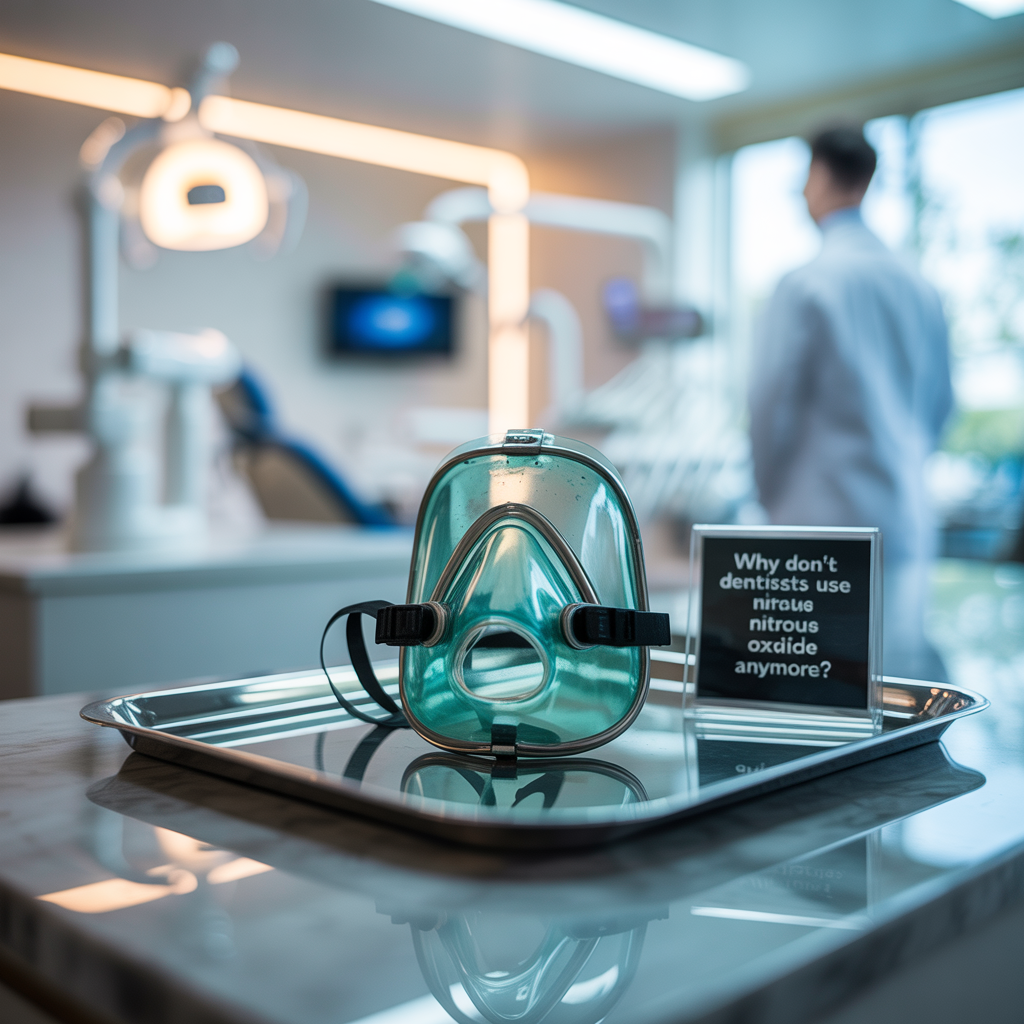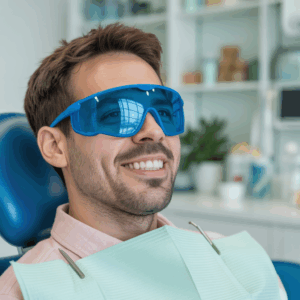Why Don’t Dentists Use Nitrous Oxide Anymore?

Plot twist: Despite people asking “why don’t dentists use nitrous oxide anymore?”, recent American Dental Association data shows 70% of practices still offer laughing gas. The reality behind this widespread misconception is more nuanced than social media suggests—here’s what’s actually happening in dental offices in 2025.
The confusion stems from a perfect storm of environmental concerns, evolving sedation alternatives, and shifting patient preferences that have transformed how and when dentists deploy nitrous oxide. But before you assume your childhood dental experiences are extinct, let’s dive into the data that reveals the true state of laughing gas in modern dentistry.
What Is Nitrous Oxide and Do Dentists Still Use It?
Nitrous oxide (N₂O), commonly known as laughing gas, is a colorless, slightly sweet-smelling gas that has been the backbone of dental sedation for over 170 years. According to the American Dental Association’s official guidelines, nitrous oxide remains “a safe and effective means of managing pain and anxiety in dentistry when used appropriately.”
The short answer: Yes, dentists absolutely still use nitrous oxide.
In fact, the Cleveland Clinic confirms that nitrous oxide is “still one of the most common inhaled sedatives used today” in both dental and medical settings. The gas works by slowing down the nervous system and inducing calm, euphoria, and mild pain relief—making it particularly valuable for anxious patients.
Here’s what makes nitrous oxide unique among sedation options:
- Rapid onset: Effects begin within 3-5 minutes
- Controllable depth: Dentists can adjust levels throughout procedures
- Quick recovery: Patients return to normal within 5-10 minutes after stopping
- No needles required: Administered through a comfortable nasal mask
- Maintains consciousness: Patients remain awake and responsive
Current Usage Statistics That Might Surprise You
Recent research published in the Journal of Dental Anesthesia and Pain Medicine reveals that nitrous oxide maintains a 94.9% success rate in clinical applications. The National Institute for Occupational Safety and Health (NIOSH) data shows that when proper safety protocols are followed, nitrous oxide concentrations in dental operatories can be effectively controlled to recommended exposure limits.
Why Some Dentists Have Reduced Nitrous Oxide Use
While nitrous oxide remains widely used, several factors have influenced some practitioners to limit or modify their approach:
Environmental and Climate Concerns
Here’s where it gets interesting: nitrous oxide is a potent greenhouse gas with 298 times the global warming potential of carbon dioxide. A 2024 study in the European Archives of Paediatric Dentistry found that a single 30-minute dental sedation session using nitrous oxide can produce the equivalent carbon footprint of driving a petrol car 1,366 kilometers.
The dental community is responding with innovative solutions:
- Improved scavenging systems that capture and neutralize waste gas
- Portable cylinder systems that reduce leakage compared to piped systems
- Optimized delivery protocols that minimize waste while maintaining effectiveness
- Alternative sedation methods for environmentally conscious practices
Advanced Sedation Alternatives
Modern dentistry offers more sedation options than ever before:
Oral Conscious Sedation: Medications like triazolam provide deeper relaxation for highly anxious patients. Unlike nitrous oxide’s mild effects, oral sedation can produce moderate to deep sedation levels.
IV Sedation: Intravenous medications offer precise control and deeper sedation for complex procedures, though they require more extensive training and monitoring.
Combination Approaches: Many dentists now use nitrous oxide alongside local anesthetics and other sedatives for optimal patient comfort.
Regulatory and Training Requirements
The CDC’s National Institute for Occupational Safety and Health has established strict guidelines for nitrous oxide use, requiring:
- Proper ventilation systems with scavenging capabilities
- Regular equipment maintenance and leak testing
- Staff training on safe administration protocols
- Personal dosimetry monitoring for dental personnel
These requirements, while ensuring safety, have led some smaller practices to reconsider their sedation offerings based on cost-benefit analyses.
The Science Behind Modern Nitrous Oxide Use
Recent advances in nitrous oxide delivery systems have actually made the technique safer and more effective than ever. According to research published in the International Journal of Clinical Pediatric Dentistry, modern delivery systems include at least 12 safety features:
Advanced Safety Features
- Oxygen fail-safe systems that automatically shut off nitrous oxide if oxygen levels drop
- Minimum oxygen percentage controls ensuring patients receive at least 30% oxygen
- Emergency air inlets providing ambient air if system failure occurs
- Color-coded equipment preventing gas line mix-ups
- Pressure monitoring alarms alerting staff to system irregularities
Precise Monitoring Capabilities
Today’s nitrous oxide systems allow unprecedented control over patient sedation levels. Dentists can monitor:
- Real-time gas concentrations
- Patient vital signs through integrated monitors
- Respiratory patterns via reservoir bag observation
- Consciousness levels through verbal response testing
Who Benefits Most from Nitrous Oxide Sedation?
Despite alternative options, nitrous oxide remains the gold standard for specific patient populations:
Pediatric Patients
The American Academy of Pediatric Dentistry strongly endorses nitrous oxide as a first-line sedation option for children. Research shows that 85.4% of pediatric patients achieve successful sedation with nitrous oxide, making it invaluable for:
- First-time dental visits
- Lengthy procedures in otherwise cooperative children
- Patients with mild to moderate anxiety
- Children who cannot tolerate oral medications
Special Healthcare Needs Patients
Nitrous oxide’s unique properties make it particularly suitable for patients with:
- Intellectual disabilities: The gas doesn’t require patient cooperation for administration
- Autism spectrum disorders: Predictable onset and offset reduce anxiety about unknown sensations
- Medical complexities: Minimal systemic effects make it safer than alternatives for medically compromised patients
Adult Anxiety Management
For adults with dental phobia, nitrous oxide offers several advantages over other sedation methods:
- Maintains communication: Patients can respond to dentist instructions
- Preserves protective reflexes: Reduces risk of aspiration or airway compromise
- Allows driving afterward: Unlike oral or IV sedation, patients can drive home independently
- Cost-effective: Generally less expensive than deeper sedation options
Environmental Solutions and Sustainable Practices
The dental profession is actively addressing environmental concerns through innovative approaches:
Waste Gas Management
Modern practices implement sophisticated scavenging systems that can capture up to 95% of waste nitrous oxide. The Society for the Advancement of Anesthesia in Dentistry recommends:
- High-volume, low-pressure evacuation systems
- Proper mask fitting to minimize leakage
- Regular system maintenance to prevent waste
- Staff education on environmental best practices
Green Alternatives and Hybrid Approaches
Some environmentally conscious practices are exploring:
- Reduced concentration protocols using lower nitrous oxide percentages
- Shorter exposure times through improved technique efficiency
- Alternative anxiolytic approaches for mild anxiety cases
- Patient education programs about environmental impacts and alternatives
The Future of Nitrous Oxide in Dentistry
Rather than disappearing, nitrous oxide is evolving. Current trends suggest:
Technology Integration
- Smart delivery systems with automated leak detection
- Digital monitoring for precise dosage control
- Integrated patient management systems tracking sedation outcomes
- Telemedicine consultations for sedation planning
Personalized Sedation Protocols
Advances in pharmacogenomics may soon allow dentists to:
- Predict individual responses to nitrous oxide
- Customize gas concentrations based on genetic markers
- Optimize sedation protocols for specific patient populations
- Minimize side effects through personalized approaches
Regulatory Evolution
Professional organizations are updating guidelines to balance:
- Patient safety and comfort needs
- Environmental responsibility requirements
- Cost-effectiveness considerations
- Practitioner training standards
Common Myths About Nitrous Oxide Debunked
Let’s address some persistent misconceptions:
Myth: “Nitrous oxide is being banned due to safety concerns.”
Reality: No regulatory body has banned nitrous oxide. The ADA, CDC, and other authorities continue to endorse its use with proper protocols.
Myth: “Modern alternatives are always better than nitrous oxide.”
Reality: Each sedation method has specific indications. Nitrous oxide remains superior for certain situations, particularly pediatric care and mild anxiety management.
Myth: “Nitrous oxide doesn’t provide real pain relief.”
Reality: While primarily an anxiolytic, nitrous oxide does provide mild analgesia and raises pain thresholds, enhancing local anesthetic effectiveness.
What Patients Should Know About Nitrous Oxide Today
If you’re considering dental treatment and wondering about sedation options:
Questions to Ask Your Dentist
1. “Do you offer nitrous oxide sedation?” – Many practices still provide this option
2. “What safety protocols do you follow?” – Ensure proper equipment and training
3. “Are there alternative sedation methods?” – Understand all available options
4. “What are the environmental considerations?” – Discuss eco-friendly practices
Preparation and Expectations
Modern nitrous oxide administration involves:
- Pre-treatment consultation to review medical history and anxiety levels
- Proper mask fitting for optimal delivery and comfort
- Gradual titration to achieve desired sedation level
- Continuous monitoring throughout the procedure
- Post-treatment oxygen to ensure complete recovery
The Bottom Line: Nitrous Oxide Isn’t Going Anywhere
Despite environmental concerns and evolving alternatives, nitrous oxide remains a cornerstone of dental sedation. The key changes aren’t about abandoning the technique—they’re about using it more responsibly and effectively.
The future of nitrous oxide in dentistry lies in:
- Sustainable practices that minimize environmental impact
- Advanced delivery systems that maximize efficiency
- Personalized protocols tailored to individual patient needs
- Integrated approaches combining multiple sedation modalities
For patients, this means continued access to a time-tested, safe, and effective sedation option—just delivered with greater environmental consciousness and technological sophistication.
The next time someone tells you dentists don’t use laughing gas anymore, you can confidently share the real story: nitrous oxide isn’t disappearing—it’s evolving for a more sustainable and effective future in dental care.
Whether you’re a dental professional staying current with industry trends or a patient planning your next dental visit, understanding the true state of nitrous oxide use helps you make informed decisions about your oral healthcare journey.


